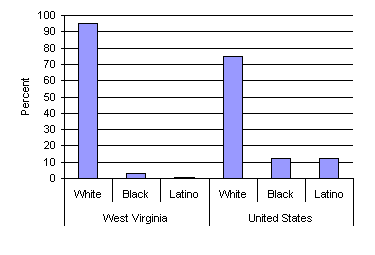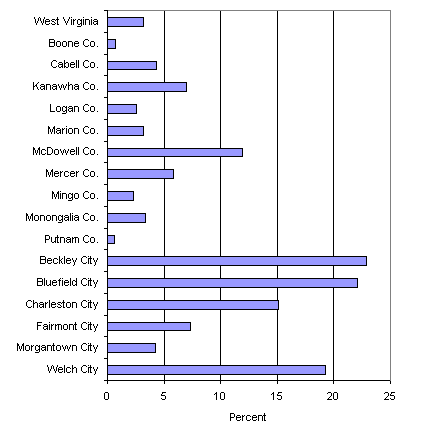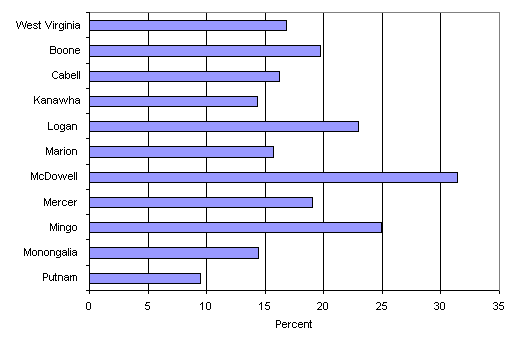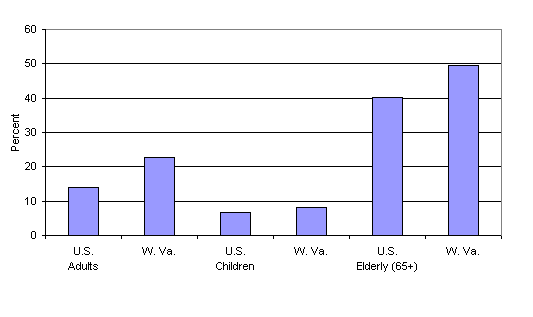
Civil Rights Issues in West Virginia
Chapter 1
Background
Since the late 1980s, the West Virginia Advisory Committee to the U.S. Commission on Civil Rights has been concerned that statewide leadership in protecting civil rights has diminished. From 1988 through 1993, as detailed in the next section, the Advisory Committee sponsored several community forums and fact-finding meetings at which panelists documented worsening civil rights problems in the state. The Advisory Committee followed up on these events by presenting a series of recommendations in its reports to state officials on actions to improve the climate.[1] This heightened attention to civil rights issues resulted in some steps forward; nonetheless, experts and community members testifying at subsequent planning meetings in 1996 and 1997 emphasized to the Committee that race relations had continued to deteriorate and that state agencies had failed to address this problem adequately.
To explore these issues in greater depth and spur stronger efforts for change, the Committee held three community forums across the state, in Logan in November 1998, Morgantown in June 1999, and Charleston in April 2000. The present report provides an overview of current civil rights issues in West Virginia based on testimony at these three forums and limited additional research, presents key findings of the Advisory Committee based on the information gathered, and sets forth recommendations of the Committee for actions to address the problems and improve the situation of civil rights in West Virginia.
Activities Leading Up to the Recent Forums
In November 1988, the West Virginia Advisory Committee urged then-governor-elect Gaston Caperton to increase the visibility of his office in the protection of civil rights in the state. He responded by sponsoring a state civil rights day on March 21, 1989. That event, coordinated by the Advisory Committee and the state Human Rights Commission, included a proclamation ceremony affirming the administration s commitment to civil rights and a Senate-House public hearing on civil and human rights legislation. The same day, the Advisory Committee held a community forum at the statehouse to examine bigotry and violence in the state, review state enforcement of civil rights, and obtain information on the state election system.[2] Of the many issues and concerns raised at the forum, perhaps the most serious was the apprehension that racial conflict would increase in the state's public schools and that state agencies did not have procedures in place to monitor and report these incidents so that necessary action could be taken.
In 1991 and 1993, the West Virginia Advisory Committee held a forum and a fact-finding meeting in Huntington and Logan, respectively, to examine mistreatment of minorities by law enforcement officials as well as allegations that racially motivated acts of violence add to overall racial tensions.[3] Participants at both events alleged that state and city police officers held negative attitudes toward racial minorities, which in turn directly affected law enforcement practices.[4] Residents in minority and low-income neighborhoods claimed that law enforcement officers exhibited a pattern of disparate treatment of African Americans, including abuse verbal and physical as well as general insensitivity to crimes committed against minorities.[5]
In its reports on these two forums, issued in 1993 and 1995, the Advisory Committee recommended that Governor Caperton (1) appoint a civilian commission to assess the need for citizen review boards to oversee police activities; (2) appoint a fact-finding task force to investigate underrepresentation of minorities and women in law enforcement; and (3) work with the state's political leadership to denounce cases of police misconduct.[6] Additional recommendations addressed alleged discrimination against blacks in the coal mining industry and racial tension in the Logan County schools. Following the release of the Committee's reports, citizens from Martinsburg, Huntington, and Charleston called for the establishment of civilian review boards for their police departments but were unsuccessful in persuading local leadership to adopt the measure.
In 1996 and 1997, the Advisory Committee held planning meetings in the Eastern Panhandle (Martinsburg), the southeastern region (Beckley), and the capital (Charleston), all areas with relatively large minority populations. At each meeting the Committee conducted an informal briefing session with state officials and community organization representatives who described persistent civil rights problems in the state. These included verbal and sexual harassment of students by their peers in public schools, excessive use of force and other abuses by police, employment discrimination, and a lack of communication and coordination among minority community leaders. Community representatives claimed that the state had not acted to ease racial tensions and address discrimination, resulting in a deterioration of race relations throughout the state. During each meeting, panelists requested that the Committee conduct a more in-depth review of the issues presented and make public its findings.
Recognizing the Committee's prior interaction with state officials, the members sought to reestablish contact with current state leaders in hope that a coordinated effort could be made to survey state civil rights issues. Toward this end, members met with Governor Cecil Underwood and other state officials in November 1997 to discuss the earlier reports as well as concerns raised at the Martinsburg and Beckley meetings. Governor Underwood was supportive of the Committee and its work, and at his suggestion the Committee participated in the civil rights summit sponsored by the governor in October 1998.
The Three Community Forums
The planning meetings held in Martinsburg and Beckley made clear that while there were statewide civil rights problems, each region of the state had its own particular issues as well. The Committee therefore selected three regions that would provide geographic diversity and illustrate a range of socioeconomic characteristics found in West Virginia, and held a one-day forum at each site to examine both statewide civil rights problems and issues unique to that region. At each forum, prominent figures in the West Virginia civil rights community, along with law enforcement and school system representatives, were invited to give testimony. Each forum also included an open session in which members of the public offered brief presentations.[7]
The Logan Forum
The forum in Logan was held on November 17, 1998, with an emphasis on follow-up to the 1993 forum and exploration of the situation in southwestern West Virginia, particularly Logan, Mingo, and McDowell counties. As noted in previous reports, this region has experienced increased racial tensions associated in part with difficult economic conditions in the area's coal mining industry.[8] The long-term decline of the industry is staggering. Statewide, more than 125,000 people were employed in coal mining in 1948; the figure had dropped to only about 15,000 by 1999, and it continues to decline.[9] Population in the counties has declined drastically as well. McDowell County, for example, had almost 99,000 residents in 1950; by 1990 the population had dropped to 35,233, and the 2000 census showed only 27,329 residents, a drop of 22.4 percent in the last 10 years.[10] Mingo County's population shrank by 16.3 percent between 1990 and 2000, while Logan County's dropped 12.4 percent. Poverty rates in the area are considerably higher than the West Virginia average. The latest county-level figures, as of 1999, from the 2000 census, show Logan County with 24 percent, Mingo County with 29.7 percent, and McDowell County with 37.7 percent living in poverty, compared with a statewide average of 17.9 percent living below the poverty line.[11]
Of the three, McDowell County has the highest percentage of African American residents, with 11.9 percent. In Mingo County, 2.3 percent are African American and in Logan County, 2.6 percent.
In this context of economic hardship, speakers at the 1998 forum in Logan testified that racial tensions in police-community relations and employment discrimination have continued, despite earlier reports calling attention to these problems. These tensions also spill over into the schools, particularly given their role as employers and the underrepresentation of minorities among school personnel. Witnesses at the Logan forum included representatives from the state Attorney General's Office, state and local police departments, local school boards, and community organizations, as well as members of the public.
The Morgantown Forum
The forum in Morgantown, held on June 14, 1999, had two panels: one focused on disability rights issues and the other on civil rights in north central West Virginia, particularly Monongalia County and Marion County.
The disability panel took advantage of expertise available from the International Center for Disability Information,[12] a program based at West Virginia University in Morgantown, which is both a national and state-level resource on disability rights. The center includes the West Virginia Research and Training Center, which works closely with state vocational rehabilitation agencies.
State-level data from the 1990 census showed that West Virginia, at 12.6 percent, had the highest percentage of people with a work disability of any state, followed by Kentucky with 11.4 percent and Mississippi with 11 percent.[13] Of those with work disabilities, the 1990 data showed the state also had the highest percentage who were not working (79.7 percent). The issue of compliance with the Americans with Disabilities Act (ADA)[14] and the Individuals with Disabilities Education Act (IDEA)[15] is therefore particularly serious for West Virginia. Issues addressed at the forum included problems in employment and education as well as other discrimination confronting people with disabilities.
The second panel examined the experiences of racial minorities in north central West Virginia, especially in the public schools. Monongalia County has slightly above the state average of African Americans as a percentage of the population (3.4 percent in 2000 as compared with 3.2 percent statewide) and Hispanics (1 percent as compared with 0.7 percent statewide); the proportion of Asian Americans in Monongalia County, at 2.5 percent, is five times the statewide level of 0.5 percent. Percentages of racial minorities in Marion County are very close to averages for the state.
North central West Virginia, and in particular Monongalia County, where Morgantown is located, has higher income levels and lower poverty levels in relation to state averages. Estimates by the U.S. Census Bureau for 1997 show median household income of $32,365 for Monongalia County, compared with the statewide median of $27,432; those below the poverty line were estimated at 14.4 percent in Monongalia County, compared with 16.8 percent statewide. Marion County had median income of $27,987, with 15.7 percent in poverty.
In addition to general issues of discrimination against people of color, speakers at the Morgantown forum stressed the low numbers of minority teachers and other staff in the public school systems of the two counties, as well as discriminatory incidents against minority students at the university level.
The Charleston Forum
As follow-up to the previous public meeting in Charleston in 1997, the forum in Charleston on April 20, 2000, focused on issues in the capital area and those statewide. Officials from state and city governments, law enforcement representatives, civil rights leaders, community activists, and members of the public presented information and views on civil rights issues, including police-community relations, recruitment and promotion practices within law enforcement agencies, discrimination in employment, and discriminatory treatment more generally.
In the Charleston metropolitan area, which includes Charleston city, areas of Kanawha County outside the city limits, and Putnam County, the African American population is 5.7 percent. People of other minority racial backgrounds are 2.3 percent of the total population, and people of Hispanic background, regardless of race, are 0.6 percent. The African American proportion rises to 7 percent in Kanawha County as a whole and 15.1 percent within the Charleston city limits, while in Putnam County it is only 0.6 percent.
The civil rights situation in Charleston, as the state capital, has received much attention from city and state government and efforts have been made to address problems; however, almost all witnesses agreed that there were still extremely serious problems in the Charleston area and around the state. A major theme in the testimony at the Charleston forum was the inadequacy of recruitment, promotion, and training for law enforcement personnel as one of the factors leading to discriminatory police behavior toward minority residents.
Demographics of West Virginia
Although there are important variations by region, county, and community, certain statewide characteristics and population and socioeconomic trends are affecting civil rights in the state. Overall, the state's population is barely growing, and it is aging significantly. The percentage of racial/ethnic minorities is growing and is concentrated in certain communities, but the population remains overwhelmingly white. Economic hardship is widespread: throughout the state, poverty, unemployment, and disability levels are higher than national averages, and educational levels and per capita income are lower.
A Slow-Growing, Aging Population
West Virginia's population grew only 0.8 percent between the 1990 and 2000 censuses virtual stagnation compared with nationwide growth of 13.1 percent; only North Dakota grew more slowly. Difficult economic conditions in the state are undoubtedly a key cause of both this lack of growth and the marked graying of the state's population, as young people seek opportunities elsewhere. Between the 1990 and 2000 censuses, the median age of West Virginians increased significantly, from 35.4 years to 38.9 years the highest median age of any state in the nation. The population aged 5 to 19 the school-age cohort decreased to 19.5 percent from 22.1 percent of the total, while the proportion 65 years and older increased to 15.3 percent from 15 percent.
Racial Minorities: Tiny but Growing
According to the 2000 census, 95 percent of the 1.8 million residents of West Virginia are white, as compared with 75.1 percent for the nation as a whole. The 5 percent minority population includes 3.2 percent of West Virginians who identify themselves as black or African American and 1.8 percent of other racial/ethnic backgrounds. People of Hispanic or Latino origin, of any race, are 0.7 percent of the state's population. Fifteen states have smaller population percentages of African Americans than West Virginia; Maine is the only state with as small a percentage of Hispanic population (see figure 1).
While the percentages of minorities in West Virginia are low in comparison with national averages, they increased between the 1990 and 2000 censuses. The African American population grew from 3.1 percent to 3.2 percent of the total. The population of other racial backgrounds jumped from 0.7 percent to 1.8 percent, and that of Hispanic origin went from 0.5 percent to 0.7 percent.
Minority populations are concentrated in certain areas of West Virginia. The population of the Charleston metropolitan area, consisting of Kanawha and Putnam counties, is 5.7 percent African American and 0.8 percent Asian American, and the percentage of African Americans within Charleston city is still higher. Monongalia County is 3.4 percent African American, 2.5 percent Asian American, and 1 percent Hispanic. The African American population of McDowell County, in the far southern part of the state, is 11.9 percent (see figure 2).
Low Levels of Education and Income
Estimates from the 2000 census put the percentage of high school graduates in the state at 75.2 percent, compared with 81.6 percent for the nation. The disparity in college graduates is even greater, with only 14.1 percent of West Virginians holding a bachelor's degree or higher, compared with 25.1 percent in the United States as a whole.
The census reports median household income in West Virginia as $28,569, only 70 percent of the national median of $41,343. Almost 10 percent of families have total income of less than $10,000 a year, compared with 6 percent nationwide. West Virginians below the poverty line are estimated at 19.3 percent, compared with 12.5 percent nationwide (see figure 3).
The average unemployment rate for West Virginia in 2000 was 5.5 percent, but the 10.6 percent joblessness rate for black West Virginians was twice the 5.3 percent rate for whites. At a national level the average rate was 4 percent, with 3.5 percent among whites nationwide and 7.6 percent among blacks.[16] Comparable detailed comparisons for household income and poverty are not yet available from the 2000 census. However, the 1990 census showed that the per capita income of black West Virginians, at $7,416, was approximately three-quarters of the figure for white West Virginians, at $10,574.
Disability rates are above the national average. In the civilian noninstitutionalized population, 8.2 percent of West Virginian children are disabled (6.7 percent nationally). Among adults 21 to 64 years of age, 22.7 percent of West Virginians are disabled (14.1 percent nationally), and among those 65 years of age and older, 49.6 percent of West Virginians are disabled (40.1 percent nationally) (see figure 4).
FIGURE 1. Racial Composition of the Population, West Virginia and the United States, 2000

Source: U.S. Department of Commerce, Bureau of the Census, West Virginia QuickFacts.
FIGURE 2. African American Population in West Virginia, Selected Counties and Cities, 2000

Source: U.S. Department of Commerce, Bureau of the Census, Census 2000 Redistricting Data, Table 5.
FIGURE 3. Population Below the Poverty Line, Selected West Virginia Counties, 1997

Source: U.S. Department of Commerce, Bureau of the Census, West Virginia QuickFacts.
FIGURE 4. Disability Rates, United States and West Virginia, 2000

Source: U.S. Department of Commerce, Bureau of the Census, Census 2000 Supplemental Survey, Profile of Selected Social Characteristics, 2000.
Organization of the Report
After this background section, this report consists of six chapters on the following topics:
Police-community relations. This chapter documents tensions between the police and citizens, especially racial minorities, and patterns of alleged civil rights violations by police; explores factors that may contribute to police-community tensions; and summarizes ongoing and suggested efforts to address these problems, as set forth by participants in the community forums.
Treatment of racial minorities and people with disabilities in the public schools. This chapter looks at the experiences of students and parents who are racial minorities or have disabilities; discusses the small number of minority employees in the schools; and examines concerns about the education of students with disabilities, especially the hearing impaired, within county school systems. The chapter concludes by summarizing some of the efforts to address these problems as well as suggestions for new approaches made by forum participants.
Civil rights issues related to employment. This chapter covers discrimination against racial minorities in hiring and welfare-to-work placements, harassment and discrimination against racial minorities in the workplace, and barriers to productive employment for people with disabilities.
Hate crimes. The chapter presents background on hate crimes and the state Hate Crime Task Force, focusing on the task force s activities and achievements to date and suggesting areas for strengthening the response to hate crimes.
A climate of intolerance. This section briefly looks at bigotry and discrimination against racial minorities in areas of public life not covered in the preceding chapters for example, discriminatory treatment in stores and restaurants which contribute to West Virginians day-to-day experiences of racial intolerance.
Findings and recommendations. The final section summarizes findings of the West Virginia Advisory Committee based on testimony from the three forums and additional research, and presents the Committee s recommendations for actions to be taken to address problems outlined in the report.
It is important to recognize that although the focus of the forums was on problems perceived by the panelists and the corresponding challenges for public policy, speakers at all three events mentioned and commended several efforts underway to respond to the problems identified. These included, among others, police-community partnerships, law enforcement training programs, school-based programs, and grassroots community-based initiatives; also described were efforts to pass state legislation, to bring complaints to state and federal civil rights agencies, and to take legal action. It is reasonable to assume that the specific initiatives mentioned by panelists are only a fraction of the efforts underway around the state, drawing on the time, talents, and dedication of West Virginians of all backgrounds who want to improve the civil rights climate in their communities.
Nonetheless, speaker after speaker emphasized the urgent need to do more, in some cases suggesting that frustrations have reached the breaking point. Some called for specific and detailed actions, while others simply indicated what they thought would be a fruitful approach. At times, as well, forum participants expressed anger over past or present injustices without making any specific recommendations, in some cases expressing pessimism that anything will ever be done.
In developing its recommendations, the Advisory Committee sought to give priority to actions viewed both as likely to have a significant impact and as reasonably feasible to carry out; accordingly, the recommendations are both fewer in number and more sharply focused than the wide-ranging suggestions made by forum participants that appear in the body of the report.
[1] See
West Virginia Advisory Committee to the U.S. Commission on Civil Rights,
Police-Community Relations in Southern West Virginia, 1993, and Rising
Racial Tensions in Logan County, West Virginia, 1995.
[2] A report of the event
titled Civil Rights Laws and Legislation in West Virginia: A Summary Report
was issued by the West Virginia Advisory Committee to the U.S. Commission on
Civil Rights in January 1990.
[3] See
West Virginia Advisory Committee,
Police-Community Relations in Southern West Virginia, and Rising
Racial Tensions in Logan County.
[4] West Virginia Advisory
Committee, Rising Racial Tensions in Logan County, pp. 26 27.
[5] Ibid., pp. 15 18.
[6] Ibid.; and West Virginia
Advisory Committee, Police-Community Relations in Southern West Virginia,
pp. 30 31.
[7] The chapters that follow
are based largely on transcripts from the three forums, which are on file at
the Eastern Regional Office of the U.S. Commission on Civil Rights.
[8] West Virginia Advisory
Committee, Rising Racial Tensions in Logan County and Police-Community
Relations in Southern West Virginia.
[9] Beth Gorczyca, West
Virginia After Coal; Peering into a Murky Future, Huntington
Herald-Dispatch, Sept. 18, 2000. Current statistics on mining employment are
available from the West Virginia Office of Miners Health, Safety &
Training at <www.state.wv.us/mhst>.
[10] Data for all demographic
information in this introduction, unless otherwise noted, come from tables
available on the Web site of the U.S. Census Bureau at <www.census.gov>.
[11] Other counties in West
Virginia also showing high poverty rates include Lincoln County, 27.9
percent; Clay County, 27.5 percent; and Webster County, 31.8 percent. U.S.
Department of Commerce, Bureau of the Census, Population
by Poverty Status in 1999 for Counties, <http://www.census.gov/hhes/poverty/2000census/poppvstat00.html>.
[12] The center's Web site
address is <www.icdi.wvu.edu>.
[13] International Center for
Disability Information, Disability Tables, n.d., <www.icdi.wvu.edu/disability/tables.html>.
[14] 42 U.S.C.
12101 12213 (1994).
[15] 20 U.S.C.
1400 1485 (1988).
[16] Bureau of Labor Statistics, Employment Status of the Civilian Noninstitutional Population by Sex, Age, Race, and Hispanic Origin, 2000 Annual Averages, n.d., <http://www.bls.gov/lau/ table12full00.pdf>.